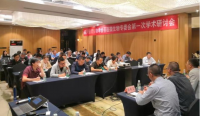Frontiers in Microbiology: 沈阳生态所在除草剂降解微生物组学研究方面取得进展播
2022-06-25 09:44 来源:农业部环境保护科研检测所

中国科学院沈阳应用生态研究所微生物资源与生态组团队在该领域进行了探索性研究,通过“自上而下”的合成生物学策略,从被氯嘧磺隆污染的土壤中富集驯化出可降解氯嘧磺隆的菌系L1,并通过宏基因组和16S rDNA测序技术对菌系在降解过程中进行了动态的微生物组学分析。相关成果发表于Frontiers in Microbiology(IF=5.640)。
博士研究生李想为第一作者,张惠文研究员、徐明恺研究员为共同通讯作者,该研究得到了中国科学院战略性先导科技专项(A类)黑土专项、沈阳市科技局重大科技成果转化(双百项目)、国家自然科学基金、辽宁省博士科研启动资金项目的资助。
阅读论文全文请点击文末阅读原文。
doi:10.3389/fmicb.2022.912312
Abstract
Excessive application of the herbicide chlorimuron-ethyl (CE) severely harms subsequent crops and poses severe risks to environmental health. Therefore, methods for efficiently decreasing and eliminating CE residues are urgently needed. Microbial consortia show potential for bioremediation due to their strong metabolic complementarity and synthesis. In this study, a microbial consortium entitled L1 was enriched from soil contaminated with CE by a “top-down” synthetic biology strategy. The consortium could degrade 98.04% of 100 mg L1 CE within 6 days. We characterized it from the samples at four time points during the degradation process and a sample without degradation activity via metagenome and 16S rDNA sequencing. The results revealed 39 genera in consortium L1, among which Methyloversatilis (34.31%), Starkeya (28.60%), and Pseudoxanthomonas (7.01%) showed relatively high abundances. Temporal succession and the loss of degradability did not alter the diversity and community composition of L1 but changed the community structure. Taxon-functional contribution analysis predicted that glutathione transferase [EC 2.5.1.18], urease [EC 3.5.1.5], and allophanate hydrolase [EC 3.5.1.54] are relevant for the degradation of CE and that Methyloversatilis, Pseudoxanthomonas, Methylopila, Hyphomicrobium, Stenotrophomonas, and Sphingomonas were the main degrading genera. The degradation pathway of CE by L1 may involve cleavage of the CE carbamide bridge to produce 2-amino-4-chloro-6-methoxypyrimidine and ethyl o-sulfonamide benzoate. The results of network analysis indicated close interactions, cross-feeding, and co-metabolic relationships between strains in the consortium, and most of the above six degrading genera were keystone taxa in the network. Additionally, the degradation of CE by L1 required not only “functional bacteria” with degradation capacity but also “auxiliary bacteria” without degradation capacity but that indirectly facilitate/inhibit the degradation process; however, the abundance of “auxiliary bacteria” should be controlled in an appropriate range. These findings improve the understanding of the synergistic effects of degrading bacterial consortia, which will provide insight for isolating degrading bacterial resources and constructing artificial efficient bacterial consortia. Furthermore, our results provide a new route for pollution control and biodegradation of sulfonylurea herbicides.
氯嘧磺隆除草剂在农业中的过量使用,带来了潜在的生态风险和毒性作用,因此开发高效稳定、切实可行且环境友好的技术,消减除草剂及其有毒中间代谢产物在环境中的残留十分必要。微生物菌系因其强大的代谢互补性和合成性显示出巨大的生物修复潜力。但现有研究主要集中于功效评价方面,鲜见关于复杂微生物菌系的群落结构组成、动态演替过程、生理代谢互作和物质协同转化等方面的报道。
鉴于此,中国科学院沈阳应用生态研究所微生物资源与生态组团队在该领域进行了探索性研究,通过“自上而下”的合成生物学策略,从被氯嘧磺隆污染的土壤中富集驯化出可降解氯嘧磺隆的菌系L1,并通过宏基因组和16S rDNA测序技术对菌系在降解过程中进行了动态的微生物组学分析。 研究发现,该菌系在6天内可降解98.04%初始浓度为100mg L-1的氯嘧磺隆,其群落组成共有39个属,其中Methyloversatilis、Starkeya和Pseudoxanthomonas的丰度相对较高。菌系L1在不同时间点的群落组成未发生明显改变,但群落结构存在显著差异。基于KEGG的功能贡献度分析预测谷胱甘肽转移酶、脲酶和脲水解酶与氯嘧磺隆的降解相关,而Methyloversatilis, Pseudoxanthomonas, Methylopila, Hyphomicrobium, Stenotrophomonas, Sphingomonas是可能的主要降解菌属。菌系L1对氯嘧磺隆的代谢途径主要通过脲桥的断裂,生成邻甲酸乙酯苯磺酰胺基甲酸酯和邻磺酰胺苯甲酸乙酯。共线性及物种-功能网络分析结果均表明不同菌属间存在密切的互作、共养和共代谢关系,这种联系不仅存在于“功能菌”之间,也存在于“功能菌”和“辅助菌”之间。本研究不仅可解析菌系降解氯嘧磺隆除草剂的微生物学机理,还提供了潜在的降解菌资源,有助于磺酰脲类除草剂面源污染生物修复技术的创制和应用。


TOP排行
- 四川省微生物学会跨界搭台 《梅花新韵》,奏响科艺融合新乐章
- 中国科学院成都生物研究所成功参与承办首届绿色燃气创新发展论坛
- 川大团队突破微生物平板标本保真技术,让课堂"看见"微观世界的模样
- 党建动态:四川省微生物学会、四川农业大学资源学院联合开展“深耕”活动助力乡村产业振兴
- 研究成果:基于 UV 胶光固化制备馆藏陈列细菌平板标本的新方法
- 四川省微生物学会专家开展“深耕”行动 推动雅江县灾后松茸生态恢复和保育促繁工作
- 四川省微生物学会开展“深耕”行动,助力泸州合江永兴诚酱油品质提升加快发展
- 快报:四川省科协十届二次常委会和全委会成功召开
- 学会申报的调研课题“关于合成生物学在四川农业与环境领域产业应用的研究”获省科协立项资助
- 四川省微生物学会联合主办开展“科普下基层”宣讲活动在四川茂县举办

